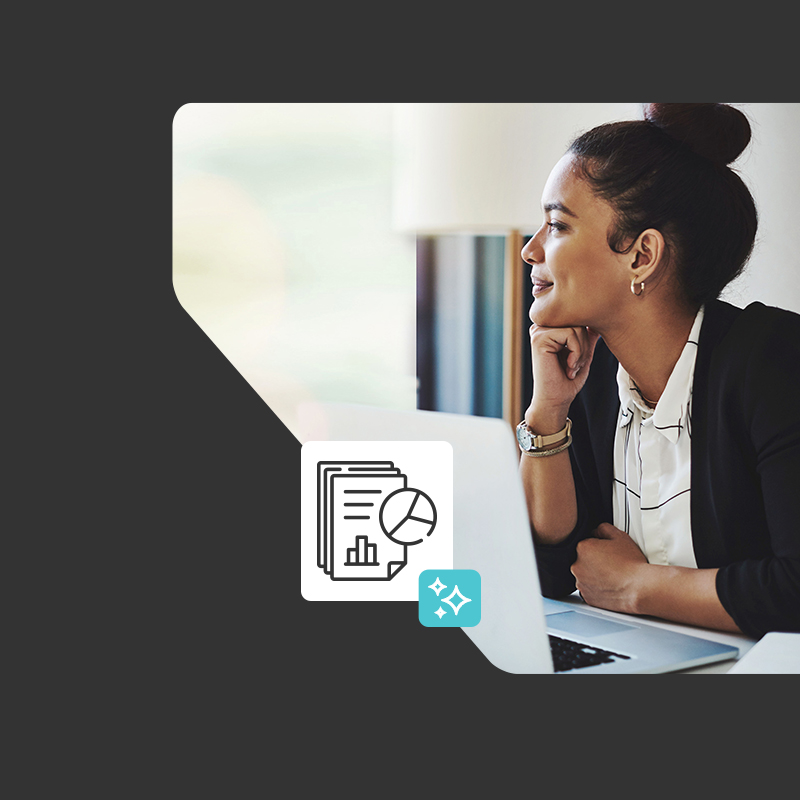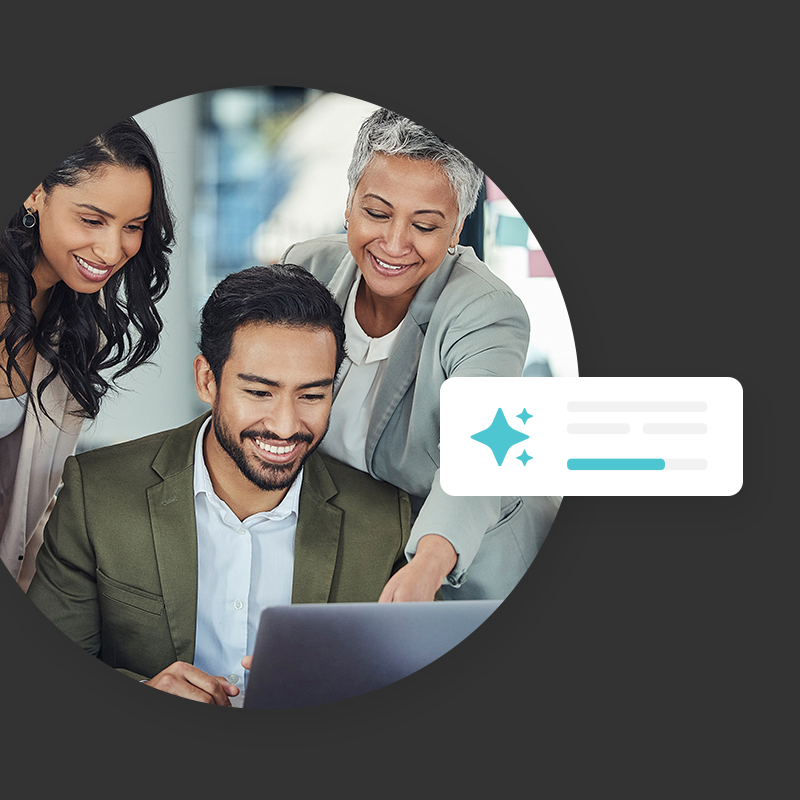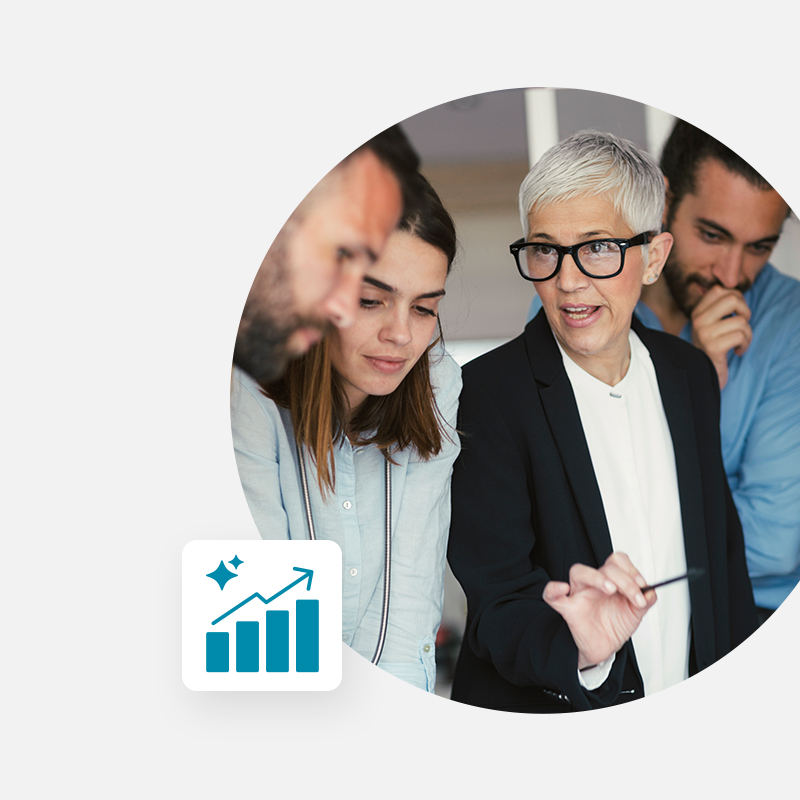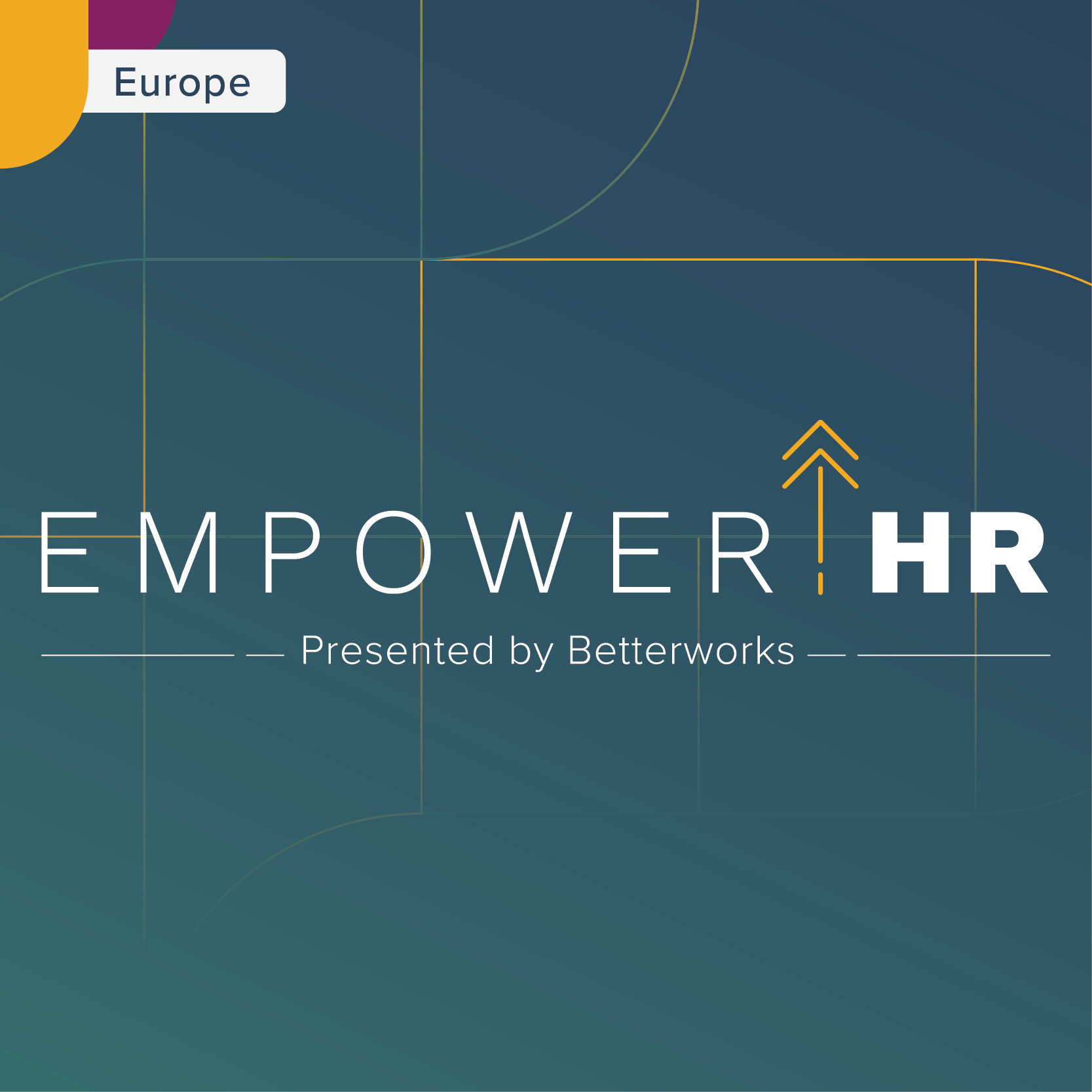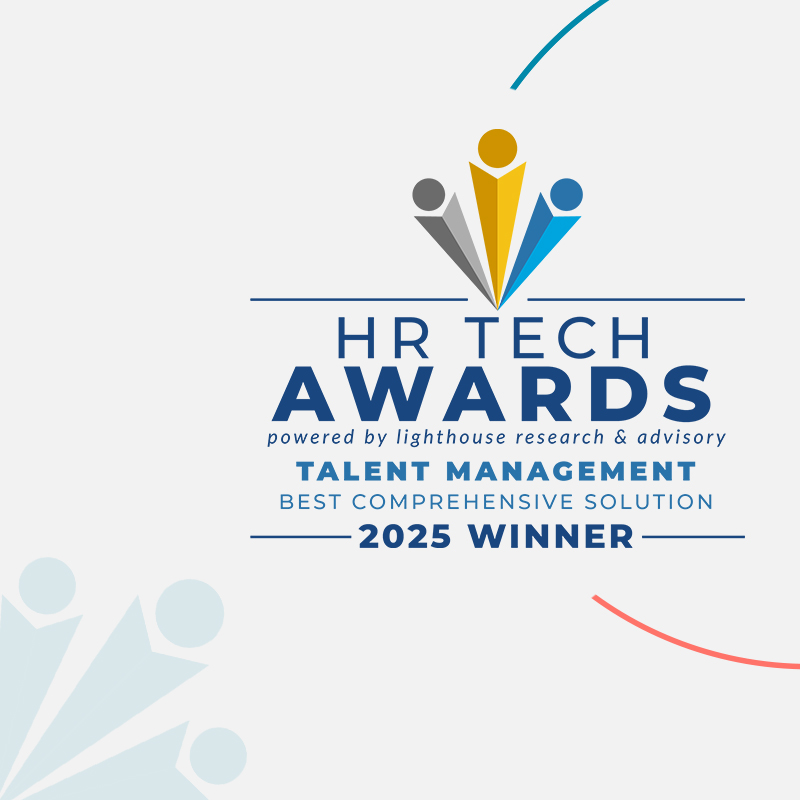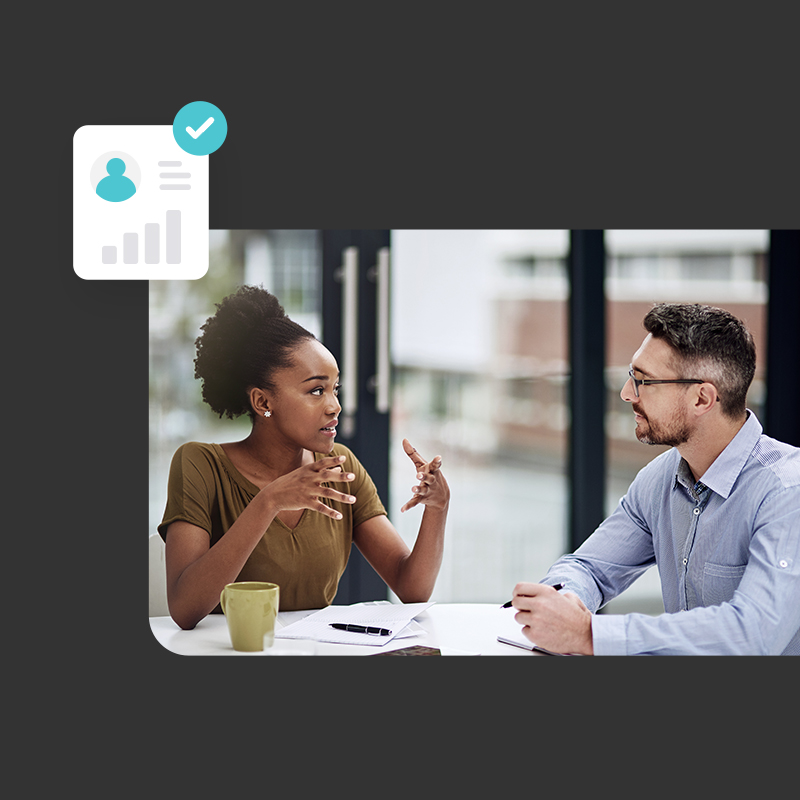- The evolving role of artificial intelligence (AI) in HR
- 3 benefits of AI in HR for your organization
- 6 AI in HR examples
- Automating routine tasks to free up time for high-value work
- Leveraging AI in HR analytics for data-driven decision-making
- Enhancing employee experience through AI-powered insights
- Driving skills development and career growth with AI
- Supporting managers with AI-driven coaching and feedback tools
- Aligning goals and performance expectations with AI analytics
- Understanding AI in HR: From narrow AI to agentic AI
- The two faces of AI: opportunity vs. anxiety
- How to mitigate risks of using AI in HR
- 3 AI in HR trends
- The future of AI in HR: Building an AI-enabled workforce
AI in HR is no longer just a tool of the future — it’s already transforming how organizations manage talent, optimize workforce performance, and support employee growth.
The implications of AI adoption extend far beyond HR. “As the most powerful general-purpose tool ever introduced to the workplace, AI is reshaping industries, changing the very nature of work, and offering innovative solutions to long-standing challenges,” says Betterworks CEO Doug Dennerline in the company’s 2025 State of Performance Enablement report.
HR leaders play a pivotal role in integrating AI into performance management and employee development. However, many organizations are struggling to harness AI’s full potential. According to Betterworks’ 2025 State of Performance Enablement report, 87% of employees who use AI daily report increased productivity, yet 93% believe they are still underutilizing AI in their roles. This gap presents an opportunity for you to lead the way in developing AI-driven strategies that enhance manager effectiveness, employee engagement, and workforce agility.
Explore how AI in HR is shifting from an assistant to a strategic co-pilot, enabling better performance, skill development, and engagement.
The evolving role of artificial intelligence (AI) in HR
AI’s role in HR has evolved from simple task automation to a strategic driver of workforce performance. Initially, HR professionals adopted AI technologies to handle administrative HR functions like resume screening and employee queries.
AI tools today have the potential to improve decision-making, identify skill gaps, and optimize workforce planning. AI-powered insights help managers track goal progress, deliver real-time feedback, provide comprehensive performance reviews, and personalize employee development, ensuring alignment between an organization’s mission and its employees.
However, this year’s report shows that higher-value strategic and creative uses of generative AI have not been as widely adopted. For example, of the 46% who use it for strategic tasks, only 22% use it for strategic planning.
HR departments must shift their focus from basic automation to AI-powered insights and enablement — harnessing AI to create personalized career paths, improve manager coaching, and foster a culture of continuous learning. The future of HR is not about replacing human decision-making with AI, but about using AI to enhance the human experience — helping employees develop their skills, engage with meaningful work, and contribute more strategically to business success.
3 benefits of AI in HR for your organization
AI tools can optimize your processes in ways that humans alone simply can’t. Here are some of the primary benefits of introducing AI into your HR processes.
Better decisions
AI’s ability to rapidly analyze large sets of data can support better-informed decisions about everything from talent management to succession planning. Predictive analytics tools, for example, can extract and provide insights based on your existing employee data. AI can use trends in data to generate suggestions to support your talent strategy. These insights can help you make better decisions, enabling your team to work alongside leaders to fulfill your company’s business needs.
Better data benefits the whole workforce, not just HR. Managers make many decisions affecting talent strategy and operational performance, and hiring managers make decisions every day that affect larger initiatives, such as succession planning and inclusion.
“When they are actually given rational data to make an informed choice, they do rise to the occasion,” said Paul Rubenstein, chief customer officer at Visier, on an episode of the People Fundamentals podcast. “And if you can give them that data … persistently, that’s how you start to change behaviors.”
Enhanced skill management
AI tools enable HR and direct managers to better support employees, empowering them to contribute their best and pursue skill development opportunities. For example, AI software can recommend career moves to employees and project a route to achieving their goals by integrating learning resources, potential career paths, and employee assessment data.
Data from Betterworks’ report reveals that two-thirds or more of all employees would like their companies to use AI to map their career paths, help them choose the best skills for a career path, and help them find and pursue internal job opportunities.
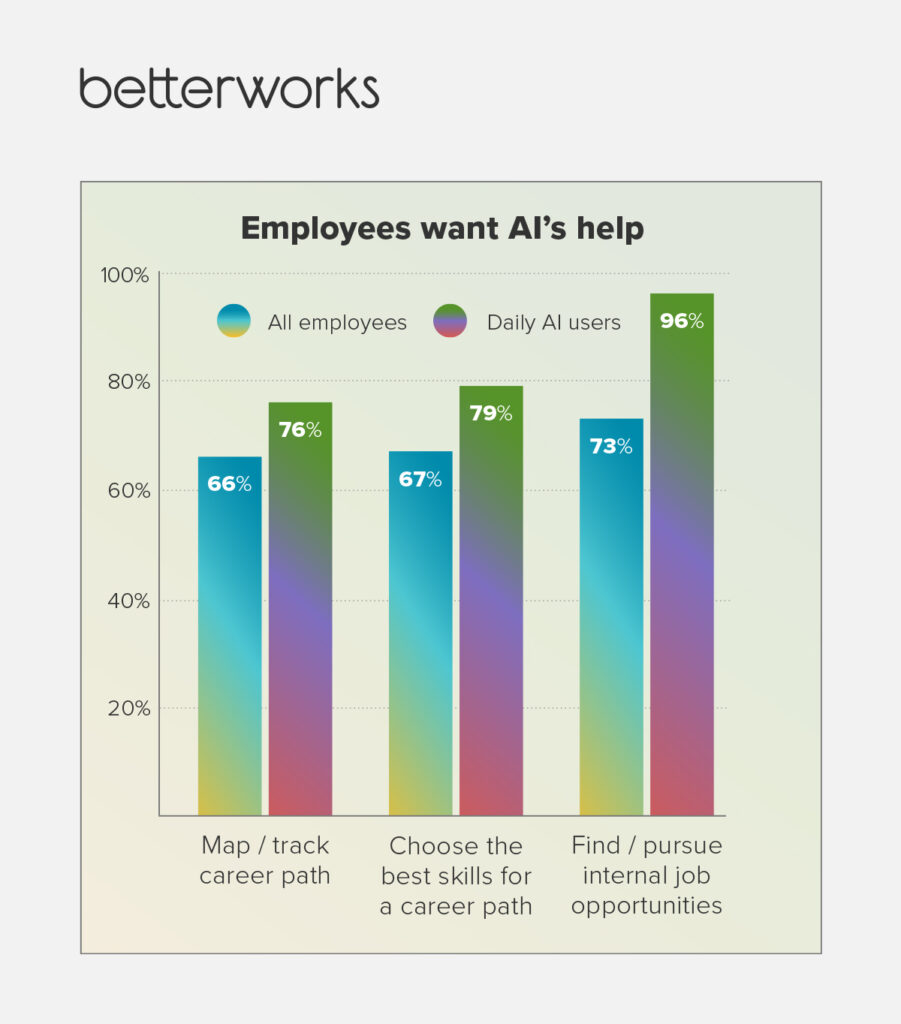
“Employees constantly want career growth and development,” said Sabrina Park, senior director of global talent management at Rivian, on an episode of the People Fundamentals podcast. “And so if you have technology to help accelerate that or make it more transparent, I think that’s all the better.”
An intelligent performance management system can track skills as employees develop them in the flow of work, giving you a better view of workforce capabilities. An AI-powered skills architecture, including in-depth talent profiles, helps employees see opportunities for growth.
“If we understand the skills that people have, we’ll be able to understand how they might be able to move in the organization,” said Stacia Garr, co-founder and principal analyst at RedThread Research, in a 2024 EmpowerHR session, “and thus enable them to have better careers and create more flexibility.”
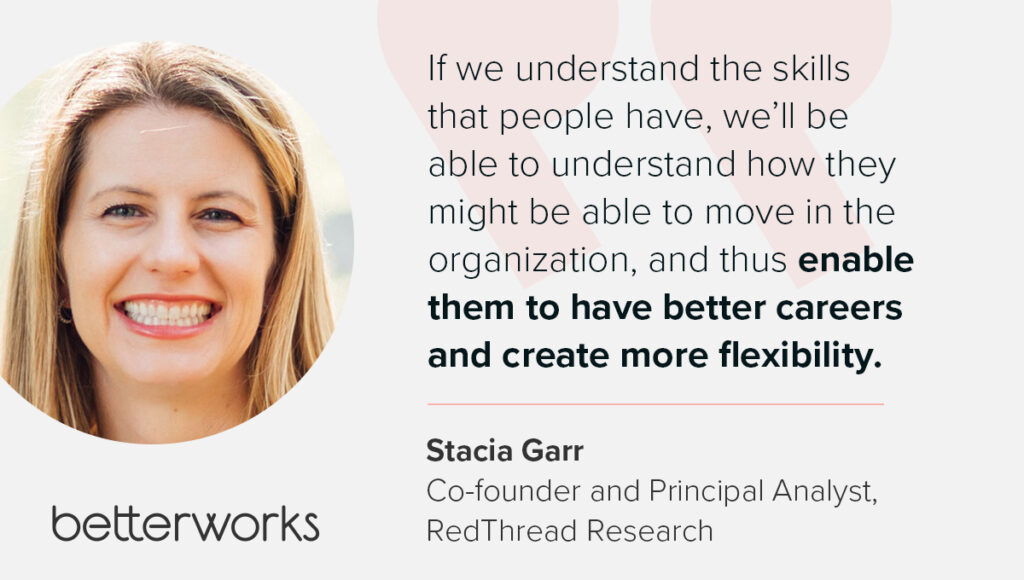
Stronger workforce alignment
AI helps employees align their goals, performance expectations, and career development opportunities with company objectives to drive both individual and business growth. AI-powered performance management solutions, like Betterworks, help HR leaders create a dynamic, transparent goal-setting process where employees clearly see how their work contributes to strategic priorities.
Instead of static annual reviews, AI-driven systems enable real-time performance tracking, continuous feedback loops, and data-backed coaching recommendations. AI can analyze an employee’s past performance to provide personalized goal suggestions, ensuring employees focus on high-impact initiatives that align with business needs. AI can also surface real-time progress insights to help managers make more effective adjustments and keep employees motivated and accountable.
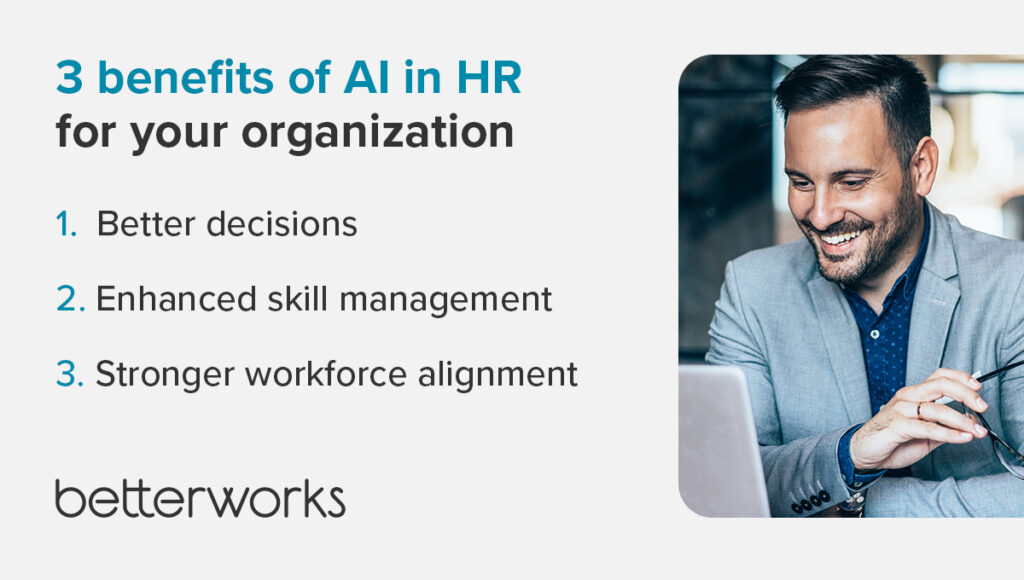
6 AI in HR examples
AI is transforming HR far beyond its initial talent acquisition and recruitment process use cases. It’s now reshaping how organizations manage performance, develop skills, and engage employees. These examples of AI in HR highlight how AI-powered tools enhance everything from goal alignment to manager effectiveness.
Automating routine tasks to free up time for high-value work
AI is eliminating repetitive administrative work, allowing HR teams and managers to focus on strategic initiatives and employee development. AI-powered tools automate scheduling, payroll processing, benefits administration, and compliance reporting, reducing manual errors and improving efficiency.
In performance management, AI streamlines goal tracking, feedback collection, manager-employee conversations, and performance evaluations, ensuring managers spend more time on coaching and engagement rather than paperwork. AI-powered chatbots also handle employee inquiries, reducing HR workload while delivering instant, consistent responses to common questions about policies, benefits, and leave requests.
Leveraging AI in HR analytics for data-driven decision-making
AI is revolutionizing HR analytics by providing real-time insights into workforce trends, employee performance, and engagement levels. AI-powered people analytics tools process vast amounts of HR data to identify patterns in retention, productivity, and skill development, helping leaders make data-driven decisions.
By analyzing feedback trends and employee sentiment, for example, AI enables you to better predict turnover risks, optimize workforce planning, and personalize development strategies. Organizations that embed AI in HR analytics gain a deeper understanding of employee needs, ensuring HR strategies are proactive, not reactive, in driving business success.
Enhancing employee experience through AI-powered insights
AI is personalizing the employee experience by analyzing engagement trends, identifying workplace challenges, and predicting attrition risks. AI-driven sentiment analysis tools monitor employee feedback, surveys, and communication patterns, helping HR identify burnout risks, disengagement trends, and areas for workplace improvement.
Additionally, AI enhances onboarding and career development experiences, offering tailored learning recommendations based on an employee’s role, past experiences, and future aspirations. AI-powered pulse surveys provide real-time feedback loops, so you can adjust engagement strategies dynamically rather than waiting for annual survey results.
Driving skills development and career growth with AI
AI is revolutionizing career development by identifying skill gaps, recommending training, and enabling internal mobility. AI-driven skills assessments provide real-time insights into workforce capabilities, helping employees and managers align career paths with business needs. AI also guides succession planning, helping you identify emerging leaders and ensuring career growth is data-driven rather than subjective.
Employees want to use AI-powered learning platforms to map career trajectories, receive personalized skill-building recommendations, and track progress toward future roles. Our research found that, among AI adopters, 79% would use AI to select the most relevant skills for their career goals.
Supporting managers with AI-driven coaching and feedback tools
AI enhances manager effectiveness by automating performance feedback, identifying coaching opportunities, and simplifying evaluation processes. AI-powered insights provide real-time recommendations for improving employee performance, flagging areas where managers should intervene with coaching or recognition.
AI also supports structured, data-driven performance reviews, reducing bias and ensuring objective evaluations. AI-powered performance tracking tools summarize key feedback trends, highlight individual contributions, and recommend targeted development plans, allowing managers to deliver more meaningful and actionable coaching.
There’s an appetite for AI tools in performance management. Our research found that nearly all (89%) managers and employees in AI-enabled performance systems report higher satisfaction.
89% of those with AI integrated into their performance management process are highly satisfied with it compared to 40% of all empoyees who don’t have AI in that process.
Betterworks 2025 State of Performance Enabalement report
Aligning goals and performance expectations with AI analytics
AI improves goal alignment by ensuring performance expectations are clearly defined, measurable, and aligned with organizational strategy. AI-powered goal-setting tools analyze historical performance data, business trends, and workforce capabilities to recommend realistic yet ambitious targets.
These tools are already creating an impact. Our research found that 90% of regular AI users report meeting goals more efficiently since the introduction of AI tools. By tracking progress in real time, AI helps HR and managers adjust goals dynamically, ensuring employees stay on course.
AI also surfaces insights into which goals can create the biggest impact, helping leaders prioritize initiatives that drive business success. This continuous tracking ensures employees understand how their work contributes to company objectives, improving engagement and motivation.
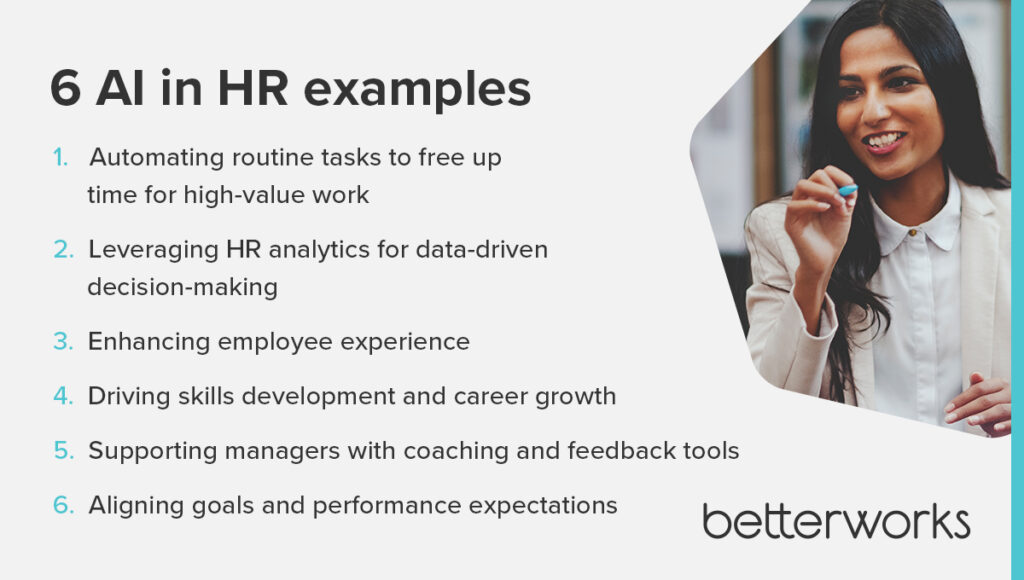
Understanding AI in HR: From narrow AI to agentic AI
AI’s evolution is reshaping how HR leaders think about automation, decision-making, and workforce enablement. While narrow AI continues to drive most HR applications today, new developments in agentic AI are paving the way for more autonomous and proactive AI systems that could redefine how HR supports employees and business strategy.
Narrow AI: The way we use AI today
The AI tools most commonly used in HR—such as ChatGPT, Gemini, Alexa, and other smart assistants—are all examples of narrow AI. These systems are designed to perform specific tasks within a defined scope, following pre-set rules and constraints.
Today’s HR-focused AI solutions, including AI-driven chatbots, resume screeners, and predictive analytics tools, fall into this category. They enhance efficiency by automating processes like candidate matching, answering employee inquiries, or generating insights from performance data. However, they cannot operate beyond their programmed capabilities or make independent decisions outside their predefined parameters.
Agentic AI: The next evolution of HR AI
Agentic AI represents a shift from passive, rule-based AI systems to AI models that can act autonomously, initiate tasks, and adapt dynamically. Unlike narrow AI, which only responds to user inputs, agentic AI can anticipate needs, make independent decisions, and optimize workflows in real time.
In the future, agentic AI could revolutionize performance management, workforce planning, and employee coaching for HR teams. Instead of simply recommending training programs, an agentic AI system could:
- Actively identify skill gaps and autonomously assign learning modules based on career goals.
- Proactively assist managers by drafting personalized coaching plans based on performance trends.
- Anticipate workforce needs and suggest talent mobility strategies before skill shortages arise.
These systems continuously learn and refine their recommendations, making them far more proactive than traditional AI.
The two faces of AI: opportunity vs. anxiety
AI is reshaping the workforce, offering unparalleled opportunities for productivity, efficiency, and career growth. But alongside this optimism, many employees remain deeply uncertain about AI’s impact on their roles, career trajectories, and long-term job security. Familiarity breeds both confidence and fear: Those who use AI regularly see its benefits, but they also worry about its potential to replace human decision-making and reshape job expectations.
The 2025 State of Performance Enablement report highlights this paradox: 49% of employees who are enthusiastic about AI also worry it will replace them. As AI adoption accelerates, HR leaders must navigate this tension by ensuring AI enhances — not threatens — employee development and job stability.
Balancing AI’s role in upskilling, career progression, and trust-building is critical. Organizations that take a human-centered approach to AI adoption will create a more resilient, AI-enabled workforce.
Determining AI’s role in upskilling and career growth
AI isn’t just automating routine tasks; it’s also reshaping skill development and career mobility. Employees who engage with AI regularly see its potential to support career progression by providing skills mapping, development recommendations, and tailored learning paths. In fact, 76% of daily AI users want AI to help track their career paths, while 96% want AI-driven insights on career growth opportunities.
AI-powered tools can identify emerging skills, recommend targeted upskilling programs, and suggest career trajectories based on industry trends and individual performance. This data-driven approach makes learning and development more accessible and personalized, allowing employees to take proactive steps in their career advancement.
Yet, not all organizations are leveraging AI’s full potential for workforce development. Many AI applications in HR are still focused on automation rather than strategic skill-building. To fully harness AI’s value, companies must integrate AI-driven learning opportunities with performance management, ensuring employees see AI as an enabler of career success, not a disruptor.
Addressing concerns about AI replacing jobs
While AI opens new career possibilities, it also fuels job security concerns. Our research reveals that employees who frequently use AI are also the most concerned about its potential for job displacement. This fear is particularly strong among high performers, who recognize AI’s capabilities but worry about restructuring and workforce downsizing.
These concerns are not entirely unfounded. AI is increasingly being used to enhance workforce efficiency, and 62% of managers see AI as a tool to replace underperforming employees. This reality makes it critical for HR leaders to proactively communicate how AI will be integrated into the workplace — not as a replacement for human talent, but as a tool to augment skills, improve productivity, and create new opportunities.
Companies that fail to address AI concerns risk losing their top AI-savvy talent as high performers are actively seeking employers that embrace AI in a way that supports career development rather than job reduction. To retain top talent, organizations must reframe AI adoption as a career accelerator, not a job eliminator.
Building trust through transparency in AI adoption
To reduce fear and encourage AI adoption, organizations must prioritize clear, transparent communication around AI’s role in the workplace. Employees are more likely to embrace AI when they understand how it’s being used, what data it relies on, and how it impacts their career prospects.
Transparency begins with leadership accountability. HR and business leaders should clearly define AI’s role, ensuring employees see AI as a support tool for career growth and decision-making rather than a mechanism for workforce reduction.
Our research underscores the need for structured AI training and adoption strategies. Employees with access to the right AI tools are overwhelmingly positive about AI’s impact on their work (90%), while those who lack AI resources report far more skepticism and disengagement (83%).
To build trust, you should:
- Be upfront about AI’s role in performance management, goal-setting, and decision-making.
- Provide clear pathways for employees to develop AI skills, ensuring they see AI as a career enabler.
- Foster a culture of AI fluency, where experimentation is encouraged and AI adoption is positioned as a growth opportunity, not a threat.
How to mitigate risks of using AI in HR
While AI’s benefits are significant, it’s also crucial to address the challenges and risks associated with its use in HR. From protecting sensitive data to ensuring fairness and maintaining trust with employees, here are some ways to minimize the risks of using AI in HR.
Protect data privacy
Given the sensitive nature of employee data, it’s imperative to prioritize data privacy and security. Advanced security measures, such as encryption, secure data storage solutions, and regular security audits, can help protect data against unauthorized access and cyber threats.
Ensure that access to sensitive data is restricted to authorized personnel only. Employing role-based access control and continuously monitoring access logs can help prevent internal data breaches.
Reduce bias in AI systems
AI systems are only as unbiased as the data they’re trained on. One generative AI challenge, for instance, might include feeding the right information into your performance management system to generate a fair and unbiased performance review.
To minimize the risk of perpetuating existing biases, use a wide range of data sources to train AI models. This helps prevent the system from developing biased algorithms based on limited or skewed data sets. Additionally, conduct periodic reviews and updates of AI algorithms to identify and mitigate against any biases that may have crept in. Employing third-party auditors can provide an unbiased assessment.
Manage employee perceptions
Transparency is key in managing employee perceptions of AI. Regularly inform employees about what AI tools are being implemented, the rationale behind their use, and how they’ll impact the work environment.
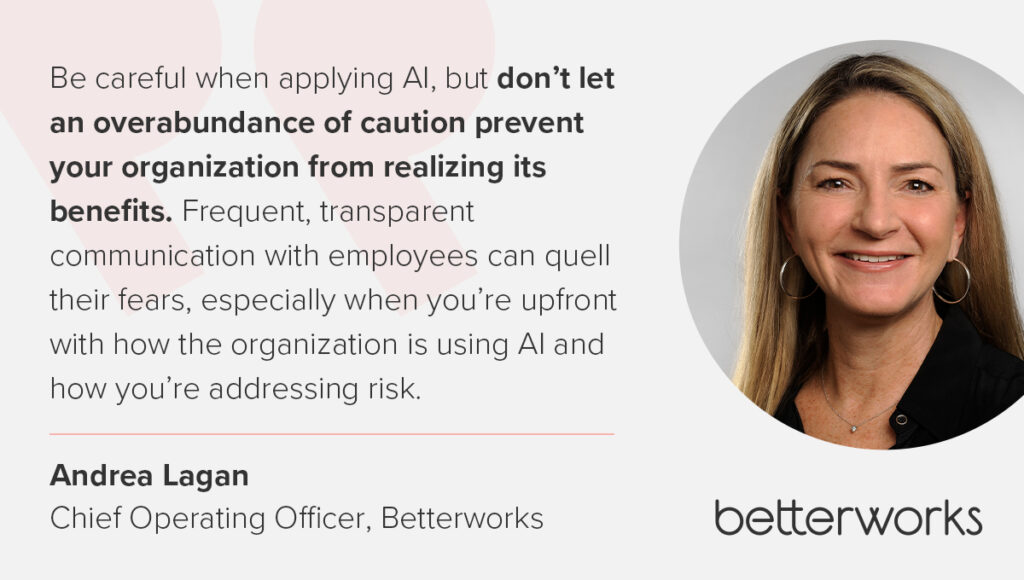
“Be careful when applying AI, but don’t let an overabundance of caution prevent your organization from realizing its benefits,” writes Andrea Lagan, chief operating officer at Betterworks. “Frequent, transparent communication with employees can quell their fears, especially when you’re upfront with how the organization is using AI and how you’re addressing risk.”
As part of your communication plan, demonstrate how AI systems benefit employees, such as through personalized training programs, more efficient HR services, or fairer, unbiased evaluations.
Engage with employees to get their input and feedback on AI tools. This can help ensure that the tools are implemented in a way that meets employees’ needs and makes them feel involved in the process.
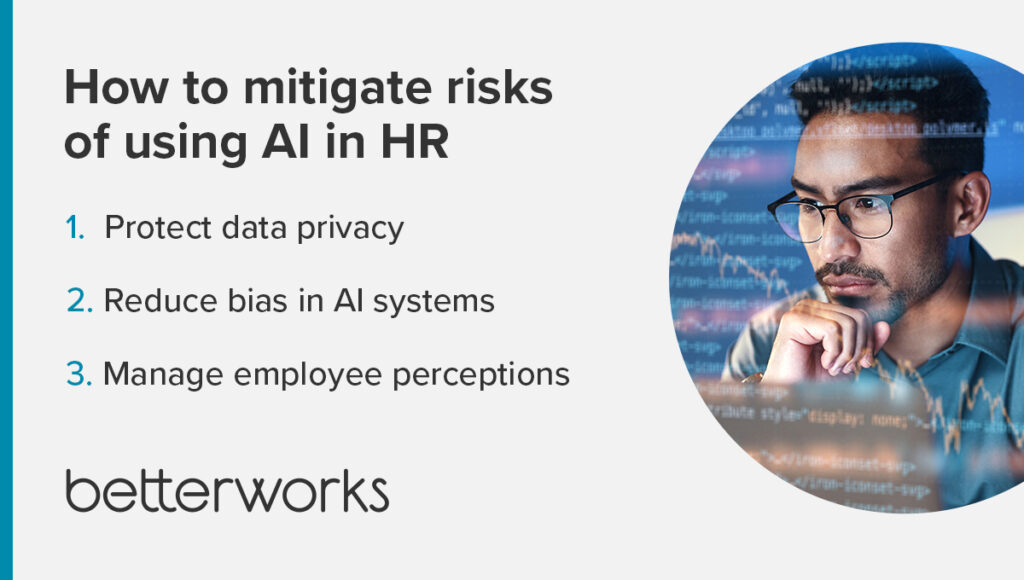
3 AI in HR trends
As AI continues to evolve, its role in HR is expanding beyond automation and analytics to create more integrated, personalized, and ethical performance management solutions.
Integration of HCMs with AI-enhanced performance tools
AI-powered performance management systems are becoming more interconnected with HCM platforms, creating a unified approach to goal-setting, compensation alignment, and workforce planning. This integration fosters a seamless flow of employee performance data across HR functions, helping you make more strategic, data-driven talent decisions.
AI-driven insights make it possible to link performance outcomes with learning opportunities, internal mobility, and retention strategies, making performance management a core driver of business success.
Generative AI for personalized performance feedback
AI is transforming performance conversations by providing real-time, tailored coaching recommendations. Generative AI analyzes employee progress, past feedback, skills profiles, and organizational goals to generate actionable, role-specific performance insights. This allows managers to deliver personalized feedback at scale, ensuring employees receive timely, relevant guidance that aligns with business priorities.
Ethical AI in workforce monitoring
AI-powered workforce analytics can help HR leaders track productivity, engagement, and burnout risks, but ethical concerns around privacy and surveillance are growing. Organizations are adopting AI responsibly by using workforce monitoring tools to support well-being and workload balance rather than enforcing rigid oversight.
AI can flag early warning signs of burnout, helping managers take proactive steps to adjust workloads, improve resource allocation, and support employee well-being — all while ensuring compliance with ethical data governance practices.
The future of AI in HR: Building an AI-enabled workforce
AI is already transforming how you manage talent, develop employees, and drive performance. The real opportunity now is using AI to create a more agile, engaged, and high-performing workforce.
By embedding AI into goal alignment, coaching, and workforce planning, you can enhance — not replace — human potential. The key is thoughtful integration: using AI to support better decision-making, enable continuous learning, and give employees greater visibility into their growth opportunities — all in the flow of work.
The future of HR isn’t just AI-powered — it’s AI-enabled. When you embrace AI as a strategic partner, you unlock new ways to support employees, strengthen leadership, and build a workplace where people and technology work together to drive success.
Want to learn more? Find out how Betterworks elevates organizational performance with AI.
How does AI use impact your employees’ sentiments?
